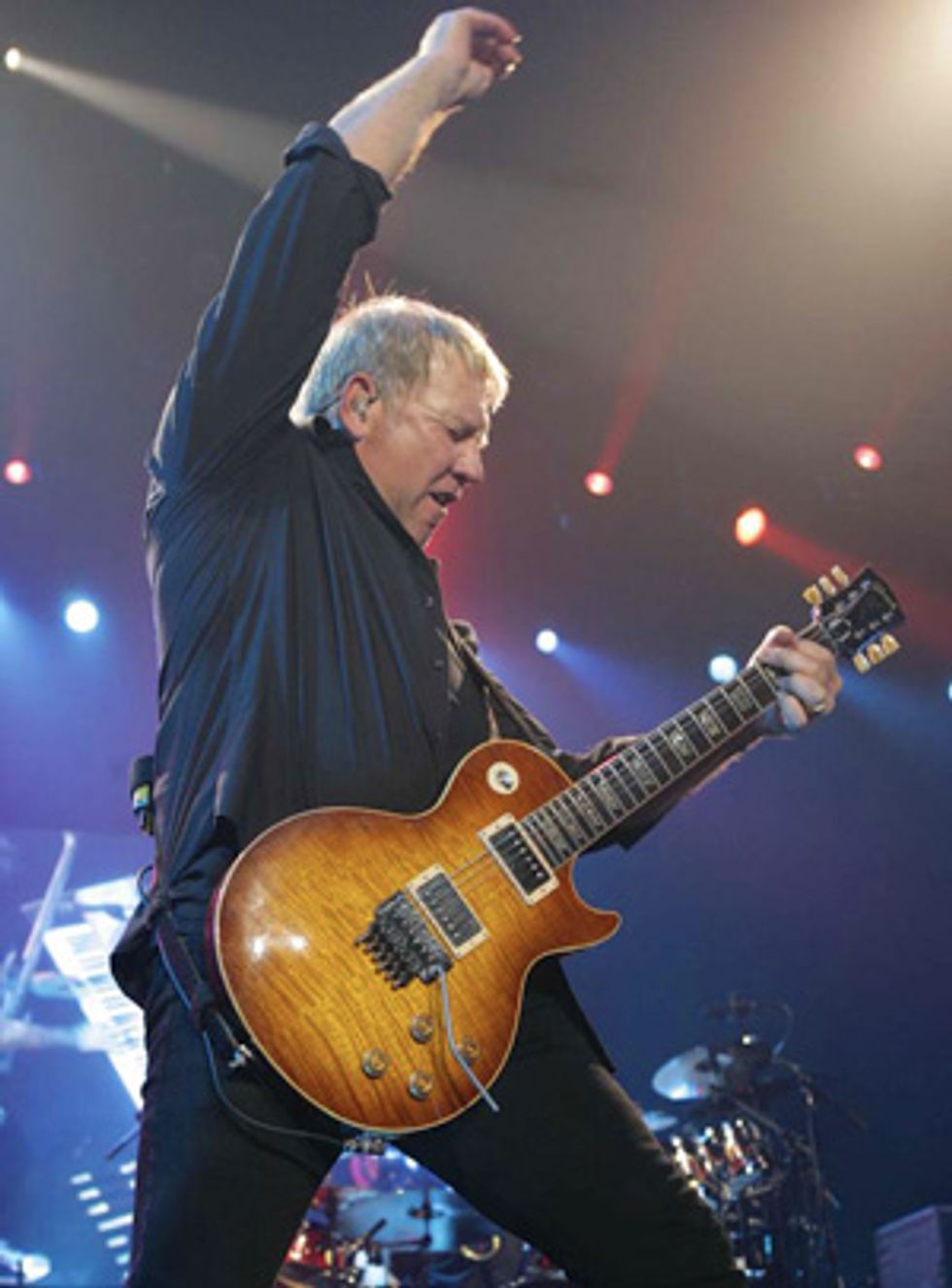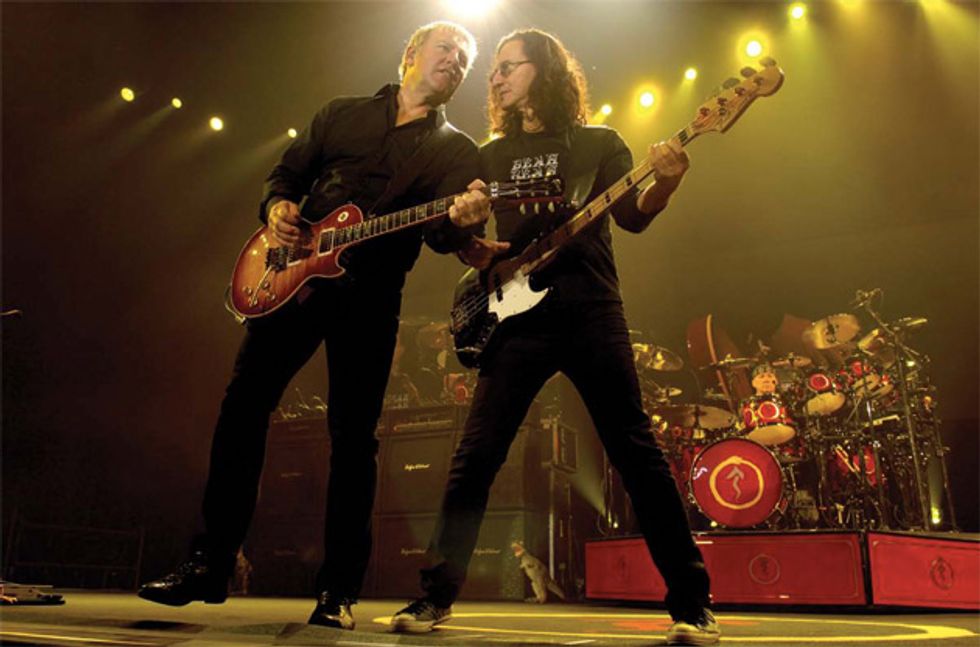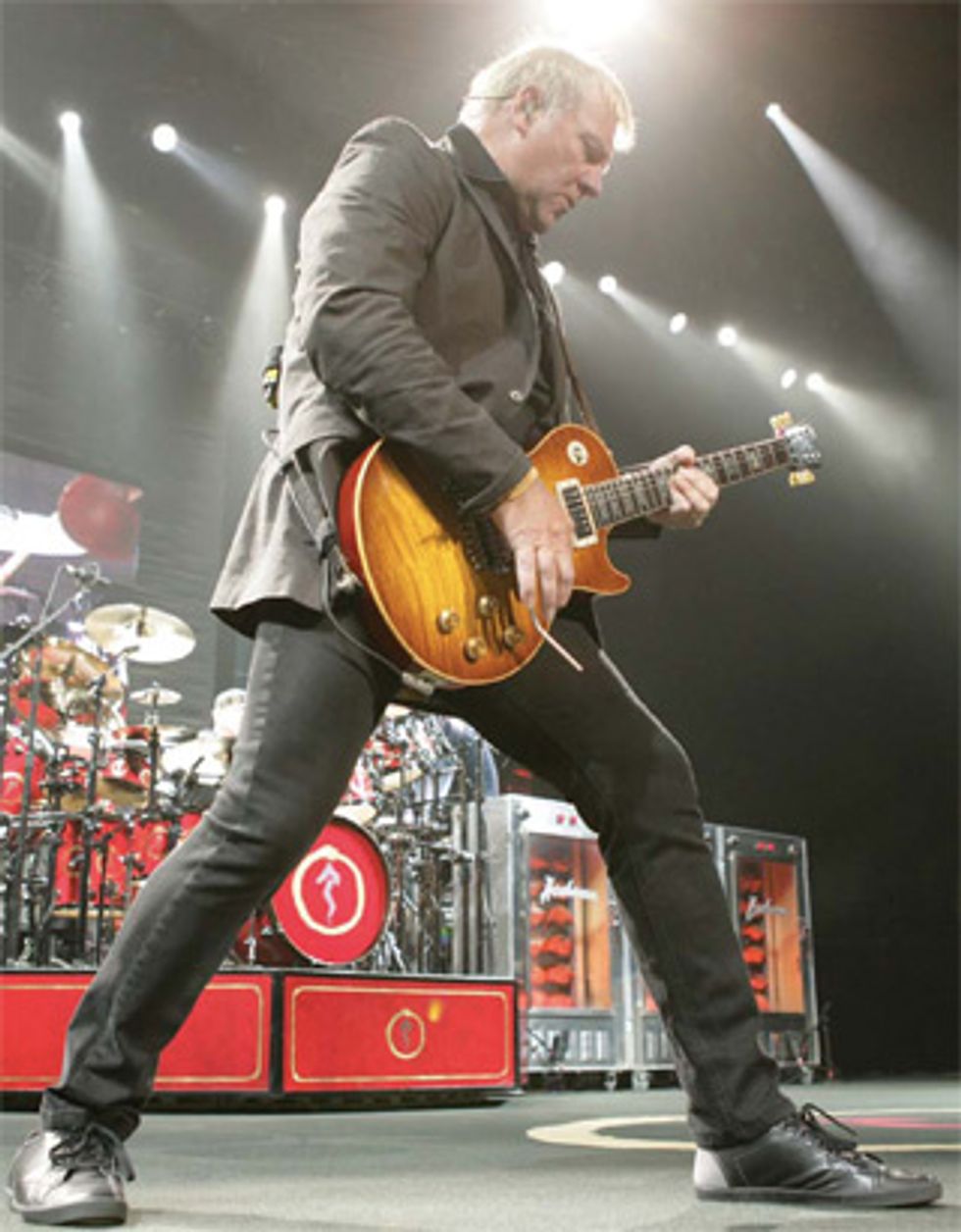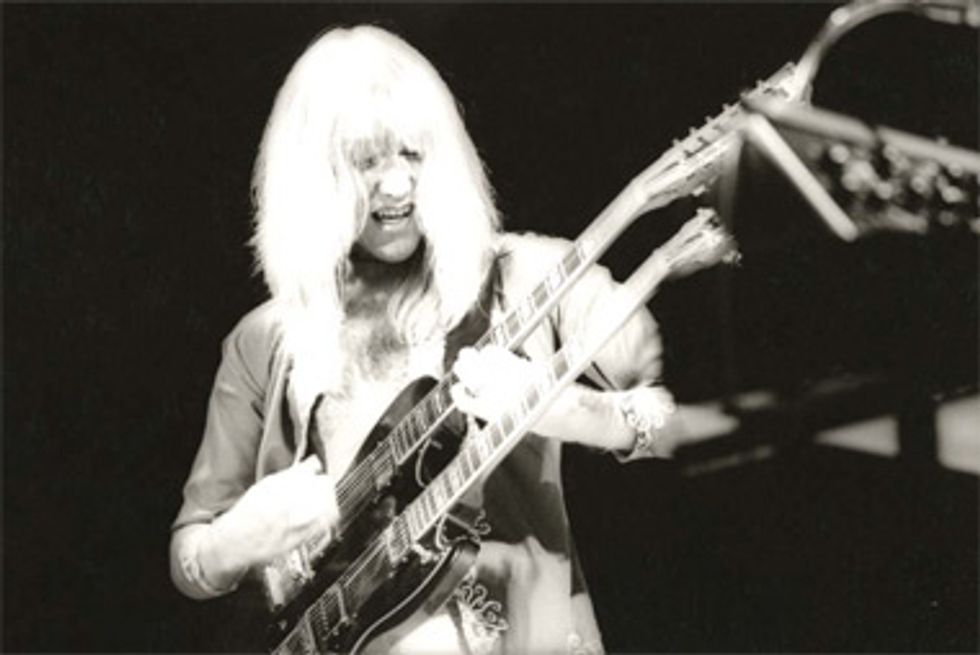Rush''s Alex Lifeson on his return to Gibson, emotional attachment to gear, and his epic gearbox.
 |
|
Snakes and Arrows was Rush’s 27th album to appear in the Billboard Top 200, and it turned into a long, good ride for the band. The album was followed by a marathon tour spanning two years and two continents, a double live album, and the November 2008 release of the three-disc DVD/Blu-Ray, Snakes and Arrows Live, in which Rush puts on a clinic on how to play a rock concert.
As a musician, Alex Lifeson has occasionally been overlooked, in part because he is a guitar player dedicated to serving the song instead of stepping on it. As most guitarists know, that kind of restraint is no easy feat. Of course, serving a Rush song can be like serving a 12-course meal. As the sole guitarist and one third of the world’s most complicated rock band, Alex has served well. About to release their twelfth compilation CD, Retrospective 3, I spoke with Alex Lifeson, and we talked about (what else?) guitars and his notable return to an all-Gibson lineup.
Congratulations on the Snakes and Arrows Live DVD/Blu-ray that came out in November! It is stunning in its sound and picture quality. I see it’s doing great in the charts.
Thank you. Yes, it’s doing very well on the charts. We were at number one for a while and then we were at number two. Then we started to slip down and now we’re back at number two.
Snakes and Arrows has been quite a ride for you guys.
Yeah, it’s been great. The tour was great, I thought we played really, really well. The recording of the album was a lot of fun. We had a great time with [Snakes and Arrows Producer] Nick Raskulinecz. We really loved working with him, and it was the first time that we made a record where we were just feeling so positive throughout the whole experience. So there was just a great energy surrounding the whole project and ending with this DVD. Particularly in Blu-ray, it has a great look to it. We filmed it over two days, so we got great angles and lots of perspectives of the band playing. It’s really a DVD about us playing, rather than in the past where we brought in different elements, like on Rush in Rio, for example. That was about that event and our connection with the audience. This one is really about our show and us playing.
Your first “real” electric guitar was your Gibson ES-335. I wonder, why that model, since the guitarists you were listening to, Jimmy Page and Jimi Hendrix for example, were playing either Les Pauls or Strats?
Well, yeah, but I was also into people like [Jefferson Airplane’s] Jorma Kaukonan, and Alvin Lee. And that guitar was always a beautiful guitar. I’ve always really liked that whole sixties San Francisco music scene, and that guitar was probably the prevalent guitar at that time. So to me it seemed like a natural place to go. And I just grew with the instrument.
You played Gibsons almost exclusively until Rush’s Permanent Waves album in 1980?
Correct.
And then you went through a Fender period?
Yeah, I sort of went through a Fender period. In fact, we did a gig with Blue Oyster Cult at the Nassau Coliseum in the late seventies, and one of the horns had fallen off of the stack and then fell on my 335, as well as a double neck that I had. It sheared a headstock off the double neck, and it took a real big gouge out of the neck of the 335. So I decided, “Okay, the 335’s going home, that’s not going to be on the road anymore.” I got a Strat as a backup, and I just wasn’t quite comfortable with it, you know, coming from the Gibson world. So I got a Schaller neck for it, and I put a humbucker in the bridge position—just fooling with it a little bit, trying to get something that was sort of a hybrid between a Gibson and a Fender.
Had you modified your Gibsons previously?
No, not really, I think the only modifications I ever did was I might have put a Bill Lawrence L-500 in one of them.
Is the ES-355 used on the Snakes and Arrows tour the original, or is it the Alex Lifeson Signature Model?
I had them both out. I used the original at the end of the show, and I used a prototype of the ‘Inspired By’ model earlier in the show on “The Trees.”
Your 355 was wired to mono. Was that just to facilitate gigging, or was there more to it?
Yeah, mostly for that reason. But I didn’t feel the need to utilize it as a stereo guitar. For me it had greater utility as a mono guitar.

| Photo: Ross Halfin |
I notice that the crowd reacts to you strapping on your ES-355. Why do you think that is?
I got that guitar in 1976, so I’ve had that guitar for quite some time, and I used it almost exclusively from that period up until around the late seventies. And I guess maybe that it’s so connected to me? That white 355, you really don’t see them around. I can’t think of anybody else that uses that particular model.
Do you use the Varitone switch live?
Not really. I think I may have in the old days when I had just the one instrument, or just a couple of guitars. That’s why I put that little micro-switch in, so I could pre-set that knob, and then just hit the micro-switch—so I’m always defaulting back to the number one position [bypass] rather than turning that rotary knob. In the studio I might use it, but live I don’t.
Was having your signature model ES-355 a big deal for you?
Yeah, it was! I was very excited about it. You know, I’ve gone through a lot of guitars over the years, and obviously at home I have lots of different guitars, and I use them all. But it was nice to come back to Gibson after not having been there exclusively for a long time. And they’ve been terrific in working with me and the kind of things I want modified on a guitar and set up the way I like. When they approached me with the 355, it just seemed to make a lot of sense. This was a model that was probably more in the background of their catalog. So it was nice to bring that to the forefront, because it really is such a beautiful instrument. It just sounds great.
Before the Snakes and Arrows tour, you were primarily using Paul Reed Smiths.
Yeah, they sent me a couple of guitars in the early nineties. I think I was using Signature at the time, which was made here in Canada. They had active pickups, and just the kind of a sound that I was going for in the late eighties. But when I started playing these PRSs, they were fantastic! They came out of the case and they were still in tune and they were set up perfectly, just the way I wanted. And for a long time I used them probably more than anything else on stage.
And really, I don’t have a problem with them. I love the instruments; I still have all of them. In fact, I’m sitting here in my office, and they just sent me a 245 to check out. But I just wanted a change. I wanted to go back to a more classic sound and a classic feel on stage. I wanted to go back to Les Pauls. That’s really the only reason. In the studio, I use everything.
In the making of the Snakes and Arrows documentary, I think every time I saw you playing it was a Tele.
Yeah, the Tele is the one I really gravitate to in the studio. It’s my favorite writing guitar. That Tele is a ‘59 reissue, but we changed a few small things on it like brass saddles, and we took the finish off the neck so it just feels really different. I love it. And for me, writing on that guitar is just a very natural kind of thing. It just feels like the right instrument for me to be writing on.
In the studio I like to incorporate that sound against something like a Les Paul or a PRS. I find that it provides a really nice contrast on top of the thickness of that humbucker sound.
What pickups are in that Tele?
Just the stock pickups.
And on the Gibsons?
On the Les Pauls that I have, I switched over to the Jimmy Page wound versions. They’ve got a nice, smooth top end, and the bottom is nice and tight. And my 355 has the same [stock] pickups that have always been in there.
Some guitarists describe the PRS tone as a Fender/Les Paul hybrid.
Yeah, I would say that’s pretty accurate, probably leaning a little more toward the Gibson side than the Fender. I think they have a unique sound, a slightly smaller, tighter sound than what the Gibson is, particularly if you look at a model like the 245 or the McCarty and A/B’d it against the Les Paul. I think the Les Paul has just a little more weight and size to it, a little more growl in the lower end of the guitar. The PRS has very nice clarity. There’s an ease in the way you play them. They do such a great job on the neck.
What do you look for in a neck?
I don’t really have a preference. The neck on my 355 is very small, and it was typical of that era in the early to mid-seventies. The neck on the ‘Inspired By’ version is a much bigger, more contemporary neck. I have to say that I really like playing that neck, too. I don’t like anything too big or too thick, but what I like is having the variety. I think there is a tendency to play a little differently when you pick up any particular instrument.
 Photo: Andrew McNaughtan |
I started with the Standard Howard Roberts. Paul Northfield, who engineered Moving Pictures and a few other records that we did, had one in the studio and it was just beautiful. So I ordered one from Gibson way back in ‘78 or ‘79. And then later that year or the following year, they brought out the Howard Roberts Fusion and to me, at the time, it seemed like the perfect guitar. It was a hollowbody, it looked like an oversized Les Paul, and it had a nice balance to it when you played it. So it had all the things that I looked for in a guitar, and it’s still one of my favorite guitars to play to this day.
Is the solo from “Tom Sawyer” on that guitar?
I think all of “Tom Sawyer” is on that guitar.
I assume you can’t go to a guitar shop and poke around, is that a problem for you? Do you miss it?
Well, it’s not a problem for me now, but I kind of missed it. I grew up that way. Every Saturday I used to go to our local music store, Long & McQuade here in Toronto, and they’d let me play anything on the wall—usually it was an SG—for about an hour and they’d they say, “Ok, get outta here, kid.” And then I’d come back the next Saturday, they’d let me play for an hour and then they’d say, “Ok, get outta here, kid.” To this day when I go into a music store, I feel like a kid again. There’s always something I want to buy. Whether it’s a little effects box or some picks, [laughs] everything that I don’t need! But there’s some magic about music stores.
Are you the kind of player that has an emotional attachment to a particular instrument?
Well, my 335, my 355 and that Tele, and the first CE bolt-on that I got from Paul Reed Smith, as well the one I used for most of the 1990s and early 2000s, which again was a CE bolt-on—which is not their fanciest model. Those guitars right there are probably my most important kids, and I wouldn’t want to get ridof any of them. I’d be heartbroken losing the others, but… oh, and a couple of these other Les Pauls that I have currently, because they’ve been set up exactly the way I want them. So I guess they could all go except for those.
And what about the Howard Roberts?
Well, I definitely need the Howard Roberts, yeah.
OK, so you would keep pretty much all of them?
[laughs] Yeah, now that you mention it. I’m thinking, “Well, that’s not really fair to that Gretsch sitting over there, so...”
Your gear list for the tour lists six Les Pauls, mostly Customs and Standards. Tell me about them.
Well, a couple have piezos, and a couple have Floyd Roses. One’s got a Bigsby. And the tonality is different from one to the next. I’ve got a Custom that weighs about 80 pounds, and I’m sure that that last E chord I played is still ringing out! It’s amazing! It’s such a heavy piece of wood that sustains like crazy. And then the Gold Top is great. It’s a ‘59 reissue, and I love the neck on it. That one is set up with a piezo with no vibrato. They all have their own job. They are tools for me.
There’s some debate going on about the “Swiss cheese” body Les Pauls versus the chambered body Les Pauls, do you have an opinion?
They sent me [a chambered] one and I checked it out, and it is nice to have a lighter Les Paul [laughs]. I would have to say it’s lacking a little bit, but really, I would want to spend a little more time with that guitar and put it through its paces. I got it when we were on tour, and I’d like to see how it reacts in the studio. It is kind of nice to have that little break for your shoulder, but I’m not sold on it yet.
 Lifeson in the mid-70s with his Gibson EDS-1275 that was damaged by a falling speaker horn in Uniondale, NY. After repairing a broken neck and repainting the guitar, Lifeson gave it to Eric Johnson as a gift. It was stolen from Johnson within weeks. Photo Neil Zlozower |
Well, the double neck made it to rehearsals, just in case. [Laughs] But it didn’t make it on the road this time. But you never know; it’s there, it’s waiting...
How do you go about choosing a particular guitar to play live?
Well, for this tour, because I had a lot of tunings and different requirements I had to try to set up for, it made the whole selection process much easier. But I think increasingly over the years I like to mix it up a bit, even if it’s just bringing one particular guitar for one or two songs. I know it drives Bucky [Alex’s guitar tech Bob ‘Bucky’ Huck] crazy because it’s just that many more string changes he has to do on a daily basis. It’s a lot of fun to have all these instruments around for a three-hour show.
How loud is Rush on stage?
You’d be shocked! I’m sure your stereo at home is louder. The loudest thing on stage is Neil’s drums, acoustically. There’s no monitors on stage. Geddy goes direct so there’s no bass rig on stage. My amps are down very low, just loud enough so that I can get some feedback if I step right up to them. And the reason we do that is we want to have a nice, manageable sound on stage that we can pump clearly through the PA.
How much guitar is in your in-ear monitors?
My mix tends to be pretty representative of the whole sound. I have a nice, full drum mix and keys in stereo, and vocal and bass up the middle. I probably have a little more ride cymbal, hi hat, snare and kick, in the whole balance of the drums. The guitars I typically have on the left side, and then I do a short eight-millisecond delay on the right side, just so I can get guitar hard left and hard right.
When is Rush going back into the studio?
Well this tour, it really, well… it killed us! We did 120 shows on this tour. The show is over three hours, and we’re no spring chickens, that’s for sure. So we decided we would take a year off and get it out of our systems. Whether Geddy and I get together sometime in the spring and do a little bit of casual writing, that’s fine. And we probably will—we get a little antsy. But I don’t think we’ll get into anything until the fall, and whether that’s going to be a new record or another tour or what exactly, I’m really not sure. I’m assuming at this point we would be working on another album.
Is it hard to decide what songs to play live?
Well, it’s really hard with all of this material, and we have so many songs that we sort of have to play. As much as I enjoy playing on everything, I kind of get a little tired of it. It would be fun to do some stuff that we haven’t done in a long time. I think it would be really interesting and keep us on our toes, and that would make for a very interesting DVD as well.
Any chance of another a solo album for you?
You know, I just did a big renovation in my studio, and Rich Chycki, who engineered the last couple of records and DVDs, has moved in with me so we’re planning on doing a lot of things. I’d like to do a little bit more producing, working with some other artists, and I’ve thought about doing another solo project… that’s definitely along there somewhere on the stovetop. We’ll see.
ALEX'S GEARBOX
| Guitars 1 Gibson Black Les Paul Custom 2 prototype Gibson Les Pauls with Floyd Rose tremolo 3 reissue Gibson Les Pauls (’59 Gold top, ’58 sunburst, ’59 tobacco sunburst) with Fishman piezo system 2 Gibson Howard Roberts with Fishman piezo system (one Fusion with Tune-O-Matic Bridge) 2 1976 Gibson ES-355s (Alex’s 1976 original and Alex Lifeson ‘Inspired By’ Model) 1 Garrison OM-20 Octave Mandolin 3 Martin D12-28 Acoustic Guitars Amps and cabinets 2 Hughes & Kettner Switchblade 100 Guitar Amp Heads 2 Hughes & Kettner Alex Lifeson Signature Triamp MKII Guitar Amp Heads 8 Hughes & Kettner 4X12 Guitar Cabinets |
Effects and Routing Furman PL-8 and PL Plus Power Conditioner 1 Dunlop DCR 1SR rack wah 1 Ernie Ball 250k volume pedal 1 Mesa Boogie 4channel amp switcher 2 Axess Electronics CFX4 Amp Switchers 2 Axess Electronics GRX4 Guitar Router/Switchers 2 Behringer Ultralink MX-662 6 Channel Splitter/Mixers 4 Audio Technica AEW 5200 Guitar Wireless Receivers 3 Fishman Aura Acoustic Guitar Modelers 2 Custom Audio Japan GVCA-2 Rev.3 Midi Programmable Volume Controls 1 TC 1210 Spatial Expander + Stereo Chorus/Flanger 1 Behringer XR4400 Multigate Pro 4 TC Electronics G-Force guitar effects processors 2 Hughes & Kettner Rotospheres 3 Palmer PDI 03 Speaker Simulators |
From Your Site Articles


